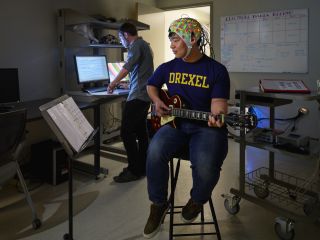Flow
If You Want the Flow You Have to Let It Go
Creativity comes from extensive training and letting your brain do its thing.
Posted March 16, 2024 Reviewed by Ray Parker
Key points
- Flow state and creativity are interlinked.
- Regional changes in brain activity while in flow suggest reduced frontal cortex regulation.
- Achieving high flow requires expertise and a willingness to relinquish conscious control.
- Less can be more when it comes to control and creativity.
The "flow state" is often described as effortless performance without conscious attention. It's associated with extreme enjoyment, high performance, and creativity. However, how it arises in our brains has not been well understood.
Flowing With Kung Fu Panda on a Mountain Bike
Most of my experiences with the flow state have come from martial arts training, especially free-form fighting and mountain biking. These activities require spontaneous and unplanned responses that definitely fall in the category of creative reactions. Upon "exiting" these experiences, I've always been left going, "Wow, that was cool, but what the heck just happened?"
Few studies have examined the neurobiology of the flow state during spontaneous creativity, which is why I found a recent study from Drexel University's Creativity Research Laboratory so interesting.

Let Your Brain Do All That Jazz
David Rosen, Yongtaek Oh, Christine Chesebrough, Fengqing (Zoe) Zhang, and John Kounios at Drexel University used a creativity task and improvised jazz guitar task along with measurement of regional brain electrical activity to investigate the flow state. They found that in musicians, high-flow "improvisations were associated with transient hypofrontality." The alterations in regional brain activity were related to the experience and expertise of the guitarists.
The researchers suggest that their results "are consistent with the idea that creative flow represents optimized domain-specific processing enabled by extensive practice paired with reduced cognitive control." Overall, they summarize that "high-flow versus low-flow is associated with greater left-hemisphere activity and reduced frontal and default-mode activity." In other words you need to train a lot and then let the brain go.
If You Wanna Just Do It, Let Your Brain Get to It
This idea of spontaneously arising creativity aligns with my earlier thoughts on how brainstorming could be a less-than-useful activity. If you truly want to experience flow and creativity, work is required to set the stage. But then, things need to unfold spontaneously. In a nutshell, peak performance requires extensive training and then getting out of your own way. Less truly is more when it comes to tapping into your own potential.
(c) E. Paul Zehr (2024)
References
Rosen D, Oh Y, Chesebrough C, Zhang FZ, Kounios J. Creative flow as optimized processing: Evidence from brain oscillations during jazz improvisations by expert and non-expert musicians. Neuropsychologia. 2024 Feb 21;196:108824. doi: 10.1016/j.neuropsychologia.2024.108824. Epub ahead of print. PMID: 38387554.


